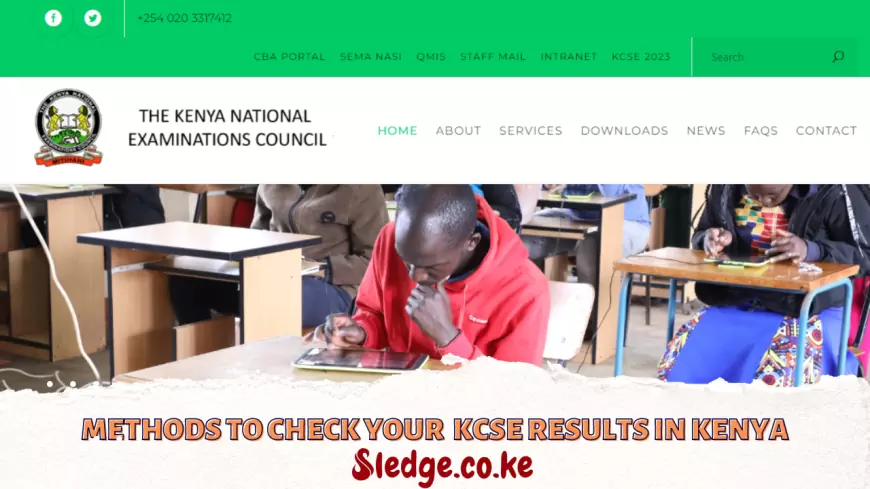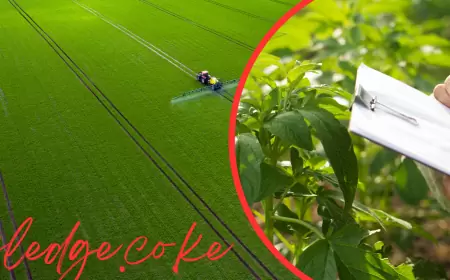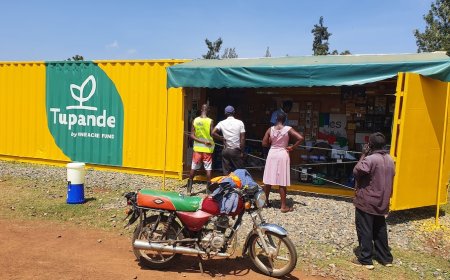How To check KCSE results Using KNEC online Portal: 2024 Guide
Discover the ultimate guide to Check KCSE Results in Kenya 2024, covering exam insights to result access – your key to success!

The Kenya Certificate of Secondary Education (KCSE) is more than just an academic milestone in Kenya; it's a pivotal moment that shapes the future of thousands of students nationwide. As the gateway to higher education and numerous career opportunities, the announcement of KCSE results each year is met with anticipation, excitement, and nervousness.
In 2024, the Kenya National Examinations Council (KNEC), the authoritative body overseeing these examinations, continues to harness the power of technology to disseminate these crucial results. The KNEC portal, an online platform, has emerged as a central hub for accessing KCSE results swiftly and efficiently. This digital shift represents a stride in educational advancements and underscores Kenya's commitment to integrating technology into its education system.
This comprehensive guide delves into every aspect you need to know about checking KCSE results in Kenya using the KNEC portal in 2024.
READ ALSO: Kenya Police Recruitment 2024: Eligibility, Application Forms And Vacancies- www.npsc.go.ke Portal
Understanding the KCSE Examination System
The Kenya Certificate of Secondary Education (KCSE) examination is a significant educational milestone, marking the culmination of secondary school education in Kenya. Instituted over three decades ago, this national examination has evolved, reflecting the changing dynamics of Kenya's education system. Let's delve into the heart of the KCSE examination, unraveling its structure, components, and recent updates that shape the experiences of Kenyan students.
History and Evolution of KCSE
The KCSE was first administered in 1989, replacing the East African Certificate of Education. This transition was part of Kenya's shift to the 8-4-4 education system, which comprises 8 years of primary education, 4 years of secondary education, and 4 years of university education. Since its inception, the KCSE examination has been instrumental in evaluating students' grasp of secondary education and determining their eligibility for higher education and career paths.
Structure of the KCSE Examination
The KCSE examination typically spans multiple subjects, covering various academic disciplines. Students must take exams in several compulsory subjects, including English, Kiswahili, Mathematics, and a set of elective subjects that vary depending on their chosen areas of specialization. These electives encompass sciences, humanities, and technical subjects, allowing students to showcase their strengths and interests.
Each subject examination consists of theory and practical components, where applicable. The theory exams test students' understanding and analytical skills. At the same time, practicals are designed for subjects like sciences and technical studies, assessing hands-on skills and application of knowledge.
Recent Changes in the KCSE Examination System
In recent years, the KCSE examination system has undergone significant reforms to enhance its fairness, reliability, and relevance to contemporary educational needs. One notable change is introducing a new grading system to provide a more comprehensive evaluation of students' abilities. This system emphasizes performance in mathematics and two other required disciplines, such as a language or a science subject. The aim is to recognize and reward students' strengths in specific areas, moving away from a one-size-fits-all assessment approach.
Moreover, technological advancements have been integrated into the examination process. The Kenya National Examinations Council (KNEC) has embraced digital solutions for registration, administration, and dissemination of results. This shift not only streamlines the process but also enhances the security and integrity of the examinations.
Preparing to Check KCSE Results
As the release of KCSE results draws near, students, parents, and educators alike are engulfed in a wave of anticipation. Preparing to check the results is more than just logging into a portal or sending an SMS. It's a process that involves understanding the nuances of the results release, gathering necessary credentials, and managing expectations. Let's navigate through these preparations to ensure a smooth experience when accessing the KCSE results.
Understanding the Results Release Timeline
The Kenya National Examinations Council (KNEC) typically announces the release date of the KCSE results a few days in advance. The release usually occurs a few months after the exams have concluded, giving the council ample time to mark, process, and verify the results. Keeping abreast of announcements from KNEC or the Ministry of Education is crucial, as these will provide the exact date and time for releasing the results.
Gathering Necessary Information and Credentials
Before the results are released, ensure you have all the necessary information. This includes the student's index number and the name registered for the exam. The index number, a unique identifier for each student, is essential for accessing individual results. It's also important to confirm that the details are accurate and correspond with the registration information to avoid discrepancies or delays in accessing the results.
Precautions and Preparations Before Accessing Results
Accessing the KCSE results, especially online, requires a stable internet connection. Choosing a location with reliable internet access is advisable to avoid connectivity issues during the process. If you plan to use the SMS service, ensure that your mobile device is adequately charged and has sufficient credit balance, as the service typically incurs a small fee.
Mentally and emotionally, preparing for the results is equally important. Students and parents should understand that the results reflect their performance in that examination and are not a determinant of their overall potential or future success. It's beneficial to have a supportive environment, with family members or educators present to provide guidance and encouragement regardless of the outcome.
Step-by-Step Guide to Checking Results via KNEC Portal
Accessing the KNEC Online Portal
- Initial Access: Begin by visiting the official KNEC website (www.knec.ac.ke). This site is the gateway to all services KNEC offers, including the results-checking portal.
- Navigating to the Results Section: On the KNEC homepage, look for the section or tab labeled 'Examinations' or 'Results.' Clicking on this will direct you to a page dedicated to examination results.
- Selecting the Appropriate Examination: Since KNEC administers various examinations, ensure you select 'KCSE Results.' This will take you to the area for accessing secondary school exam results.

Entering Required Details
- Input of Index Number: You will be prompted to enter the student's index number. This number is unique to each student and is crucial for retrieving individual results.
- Verification of Details: Double-check the entered index number for accuracy. An incorrect number can lead to errors or retrieval of another student's results.
- Submission: After confirming the accuracy of the index number, click the 'Submit' or 'Check Results' button. This action sends a request to the database to fetch the corresponding results.
Viewing and Understanding the Results
- Display of Results: The results should be displayed on the screen after a short processing time. In some cases, high traffic on the portal immediately after the release of results can cause delays. Patience is key in such situations.
- Interpreting the Results: The displayed results will typically include the grade scored in each subject, the total points, and the overall grade. Understanding the grading system is crucial to interpreting these results correctly.
- Troubleshooting Common Issues: If you encounter problems such as a delayed response or an error message, verify your internet connection and the accuracy of the details entered. If the problem persists, it may be due to high traffic on the website, and attempting access later is advisable.
- Alternate Access if Portal is Unavailable: In the rare event that the KNEC portal is not accessible, students can use the SMS service provided by KNEC or contact their respective schools for the results.
Alternative Ways to Check KCSE Results
While the KNEC portal is a primary method for checking KCSE results, alternative ways exist to access this crucial information. These alternatives are particularly useful if you face challenges with the online portal or prefer a different mode of accessing the results. Let's explore these alternative methods, ensuring every student can receive their results promptly and conveniently.
Checking Results via SMS Service
- SMS Method: This is a popular and straightforward method to check KCSE results. To use this service, send an SMS with the student's index number to the designated short code, which KNEC usually provides.
- SMS Format and Cost: The SMS should be in the format [Index Number] and sent to a specific code like 20076 or 40054, as announced by KNEC. Note that this service incurs a nominal fee, typically around Ksh. 25 per SMS.
- Availability: The SMS service is available on all mobile networks in Kenya and is operational immediately after the official release of the results.
Accessing Results Through Schools
- School Notice Boards: Many schools display the KCSE results on notice boards. This traditional method remains effective, especially for those close to the school.
- School Websites and Portals: Some schools may post their students' results on their official websites or dedicated student portals. This method is becoming increasingly popular as schools embrace digital platforms.
What to Do if There's a Delay in Results Release
- Patience and Verification: Delays in result releases can occur for various reasons. It's important to stay patient and keep verifying through the available methods.
- Contacting the School: If the delay is prolonged, contacting the school for clarification can be helpful. Schools often receive direct communication from KNEC about any delays or issues.
Post-Result Release: Understanding the Next Steps
- Analyzing the Results: Once you have access to the results, take the time to understand and analyze them. This includes reviewing performance in individual subjects and the overall grade.
- Guidance and Counseling: Schools often provide guidance and counseling services for students to discuss their results, future academic paths, or career choices.
- Exploring Further Options: Exploring options like remarking or re-sits can be crucial for students whose results may differ from expected. Additionally, vocational training and other non-university pathways can be considered.
READ ALSO: KNEC Portal LCBE Assessments: Comprehensive Steps for Offline & Online Uploads In 2024
Frequently Asked Questions (FAQs)
What should I do if I encounter errors while checking results online?
- If errors occur, verify your internet connection and the accuracy of the index number entered. If issues persist, try accessing the results during off-peak hours or use the SMS service.
Can I get a detailed breakdown of my marks in each subject?
- Detailed subject-wise marks are usually provided in the result slips that schools receive. Students can obtain these from their respective schools.
How can I appeal if I'm not satisfied with my results?
- KNEC provides a provision for result queries and appeals. Students can apply for a remark or raise queries through their schools, following the guidelines set by KNEC.
What are the next steps after receiving my KCSE results?
- After receiving results, students can explore various pathways like university, college, vocational training, or even enter the workforce, depending on their grades and career aspirations.
Conclusion
The journey of checking KCSE results in Kenya is a blend of anticipation, preparation, and execution. With technological advancement, KNEC has streamlined this process, making it more accessible and efficient. Whether you use the online portal, SMS service, or school-based methods, the key lies in being informed, prepared, and patient. Remember, KCSE results are a significant milestone, but they are just one of many in your educational journey. They open doors to future opportunities and should be approached with a balanced perspective.
We hope this guide has been enlightening and beneficial to all the students, parents, and educators. May this step in your academic journey be filled with success and lead to a bright and prosperous future.












































































